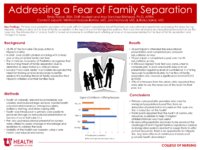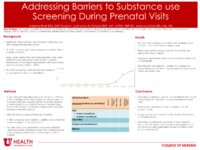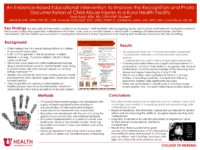The Graduate Nursing Project collection includes Doctor of Nursing Practice (DNP) Scholarly Projects and Master's students' non-thesis projects submitted as part of program requirements.
TO
- Graduate Nursing Project, Doctor of Nursing Practice, DNP, Primary Care / FNP, Poster149
- Graduate Nursing Project, Doctor of Nursing Practice, DNP, Primary Care / FNP47
- Graduate Nursing Project, Doctor of Nursing Practice, DNP, Primary Care FNP42
- Graduate Nursing Project, Doctor of Nursing Practice, DNP, Primary Care FNP, Cultural Diversity4
- Graduate Nursing Project, Doctor of Nursing Practice, DNP, Primary Care FNP, Cultural Diversity, Poster4
- More
| Title | Creator | Date | Description | ||
|---|---|---|---|---|---|
| 76 |
 |
Mock Codes: A Quality Improvement Project | Memmott, Jacob | 2020 | Background: Code blues are one of the most intense, stressful, and mistaken prone situations in all of healthcare (Hatley, Jordan, Powers, & Morton, 2019). In the long term acute care hospital (LTAC) setting, very sick patients are cared for, but not many code blue emergencies occur. Therefore, clin... |
| 77 |
 |
Osteoporosis Management: Strategies to Improve Patient Care Following a Fragility Fracture | Magiske, Kerry M.J.; Allen, Nancy A. | 2022 | Problem: A care gap exists in osteoporosis management (OPM) in females 50+ who have had a fragility fracture (FF). Clinical guidelines recommend prescribing anti-OP medications after a FF, though this recommendation is not commonly followed. The purpose of this needs assessment quality improvement p... |
| 78 |
 |
Outcomes from Reoperative Bariatric Surgery: A Needs Assessment | Crapo, Kelsey S.; Allen, Nancy A. | 2022 | Background: Bariatric surgery is the gold standard treatment for severe obesity. When weight regain, insufficient weight loss, or complications occur after bariatric surgery, a second surgery may be required. Reoperative bariatric surgery is a newer and more complex procedure with limited studies or... |
| 79 |
 |
Overcoming Barriers to ACE Screening in Primary Care | Wallace, Chiara; Doyon, Kate | 2023 | Background: Adverse childhood experiences (ACEs) are strongly linked with risk factors for the leading causes of death in adults, and recent evidence suggests that ACEs among college students are correlated with worse depression, substance use, diet, and sleep, and increased suicidal ideation. Local... |
| 80 |
 |
Palliative Care Trigger Tool in the CVICU: A Needs Assessment | Moore, Gabriella H. | 2023 | Background: Palliative care is a valuable resource that assists patients in determining their goals of care and end-of-life care preferences. Automated trigger tools can help to identify patients in the intensive care unit (ICU) who may benefit from palliative care. Problem: Several ICUs at the Univ... |
| 81 |
 |
Post-Heart Transplant Education Outpatient Screening and Referral: A Quality Improvement Project | Brady, Cariann | 2023 | Background: After heart transplant, patients are given an overwhelming amount of information before discharge. Studies show that comprehension among hospitalized patients is poor, and, on average, they immediately forget 40-80% of what they are taught, and surgery can further hinder the learning and... |
| 82 |
 |
Precipitous Delivery Protocol in Urgent Care | Daniel M. Fidler; Melissa Baker; Lisa Taylor-Swanson | 2024 | |
| 83 |
 |
Preventing the Use of Anti-Reflux Medication in Infants Diagnosed with Cleft Palate through Lifestyle Interventions | Madsen, Kayley A.; Sylvester, Robert; Clifton, Jennifer | 2022 | Background: Gastroesophageal reflux is a highly prevalent condition in infants, particularly those with a cleft lip or palate. Children with cleft lip or palate are much more likely to be treated with an anti-reflux medication than the general population of infants. While anti-reflux medication is i... |
| 84 |
 |
Quality Improvement Project to Improve Cognitive Screening in Patients with Diabetes | Dalley, Necia | 2020 | Background: The largest growth in patients with diabetes is expected to be in those over the age of 65. Two risk factors for developing dementia include age and diabetes. In fact, type 2 diabetes increases dementia risk two-fold. About 50% of the time, dementia is preceded by mild cognitive impai... |
| 85 |
 |
Quality Improvement Project: Improving Pediatric Primary Care Screening and Response for Postpartum Depression by Implementing a Referral Protocol | Bermingham, Mekenna A. | 2023 | Background: Maternal mental health is a rising problem in Utah; one-in-eight women are affected by postpartum depression (PPD). A Utah review of maternal deaths found that 65% occurred after 43 days postpartum, meaning the routine 4-week postpartum obstetric follow-up is a missed opportunity to prev... |
| 86 |
 |
Reducing Cardiometabolic Risk in Women Through Goal Setting and Virtual Interval Follow Up | Very, Katrina; Phares, Pamela | 2022 | Background: Cardiometabolic (CM) disorders are primarily lifestyle-induced and cause significant morbidity and mortality in women. Heart disease is responsible for 1 in 5 female deaths and is the leading cause of death for women in the United States. Diminishing the consequences of CM disorders is w... |
| 87 |
 |
Reducing Rates of Adolescent Electronic-Cigarette Use by Effective Primary Care: A Quality Improvement Project | Horton, Matthew A. | 2020 | Background: Primary care providers have the ability to combat false perceptions about electronic cigarettes' safety. Research shows screening and education are needed in primary care. Despite the increased use of electronic cigarettes (EC) among adolescent youth (AY) populations ages 11-18 years-old... |
| 88 |
 |
Running Head: HPV Vaccine Recommendation Practices in a Suburban Family Practice Clinic | Wiley, Nathan H. | 2020 | Background:Human Papillomavirus (HPV) vaccination is an effective method for preventing 9 types of HPV infection which cause the vast majority of HPV-related cancers. However, Utah maintains consistently poor HPV vaccination rates among adolescents aged 13 to 17. The National Institutes of Health ... |
| 89 |
 |
Safe Environment for Every Kid: Screening Tool Implementation for Quality Improvement in a Primary Care Pediatric Clinic | Collins, Whitney | 2020 | Background Child abuse and neglect are significant issues in our world today with over 700,000 substantiated cases annually, costing our country more than 124 billion each year. More than four children die daily in the United States due to child maltreatment and yet it is rarely addressed in the pri... |
| 90 |
 |
Sexual and Reproductive Health Education for Adolescents with Cystic Fibrosis | Taylor, Courtney S. | 2020 | Background: A cystic fibrosis (CF) center in the Intermountain West identified a gap in care with no standard sexual and reproductive health (SRH) guideline for CF providers and no data specific to their patients' SRH needs. Parents, adolescents, and providers consistently report the importance of a... |
| 91 |
 |
Stop the Bleed: A Needs Assessment for the School-aged Population | Alejandro B. Moreno; Janet F. Cortez; Jennifer L. Hamilton | 2024 | |
| 92 |
 |
Suicide Prevention in a Rural, Critical Access Emergency Department: Development and Implementation of a Suicide Care Toolkit | Kinsey, Elizabeth S. | 2023 | Background: Suicide has become one of the leading causes of death in the United States during recent years. Throughout this time, Utah experienced one of the nation's highest suicide rates. During the onset of the coronavirus pandemic of 2019, hospitalizations for suicidality drastically increased t... |
| 93 |
 |
Triage of Pregnant Women in the Urgent Care Setting: A Quality Improvement Initiative | Hansen, Emily N.; Al-Khudairi, Amanda | 2022 | Background: Pregnant women often seek care at urgent care (UC) facilities over more appropriate settings designed for tailored triage like Obstetric Emergency Services (OBES) at University of Utah Medical Center. Improper triage and poor interdepartmental transfer of pregnant women has been strongly... |
| 94 |
 |
A Standardized Specimen Labeling Process To Decrease Pre-Analytical Biopsy Errors | Jessen, Chris; Lynch, Keisa | 2021 | POSTER |
| 95 |
 |
A Standardized, Incremental Training Model in the University of Utah Emergency Department | Crepeau, Scott B.; Garcia, Kimberly; Evans, Alexandra | 2022 | POSTER |
| 96 |
 |
A Study of Micronutrient Deficiencies After Bariatric Surgery | Nickel, Alexa | 2018 | POSTER |
| 97 |
 |
Adapting and Implementing Guidelines for Managing Sleep Disturbances in Incarcerated Youths | Jacobs, Elizabeth L. | 2023 | POSTER |
| 98 |
 |
Addressing a Fear of Family Separation | Navar, Emily | 2019 | POSTER |
| 99 |
 |
Addressing Barriers to Substance Use Screening During Prenatal Visits | Reid, Adriana; Schultz, Catherine H.; Smid, Marcela | 2021 | POSTER |
| 100 |
 |
An Evidence-Based Educational Intervention to Improve the Recognition and Photo Documentation of Child Abuse Injuries in a Rural Health Facility | Byrd, Tami L. Fikstad | 2018 | POSTER |
